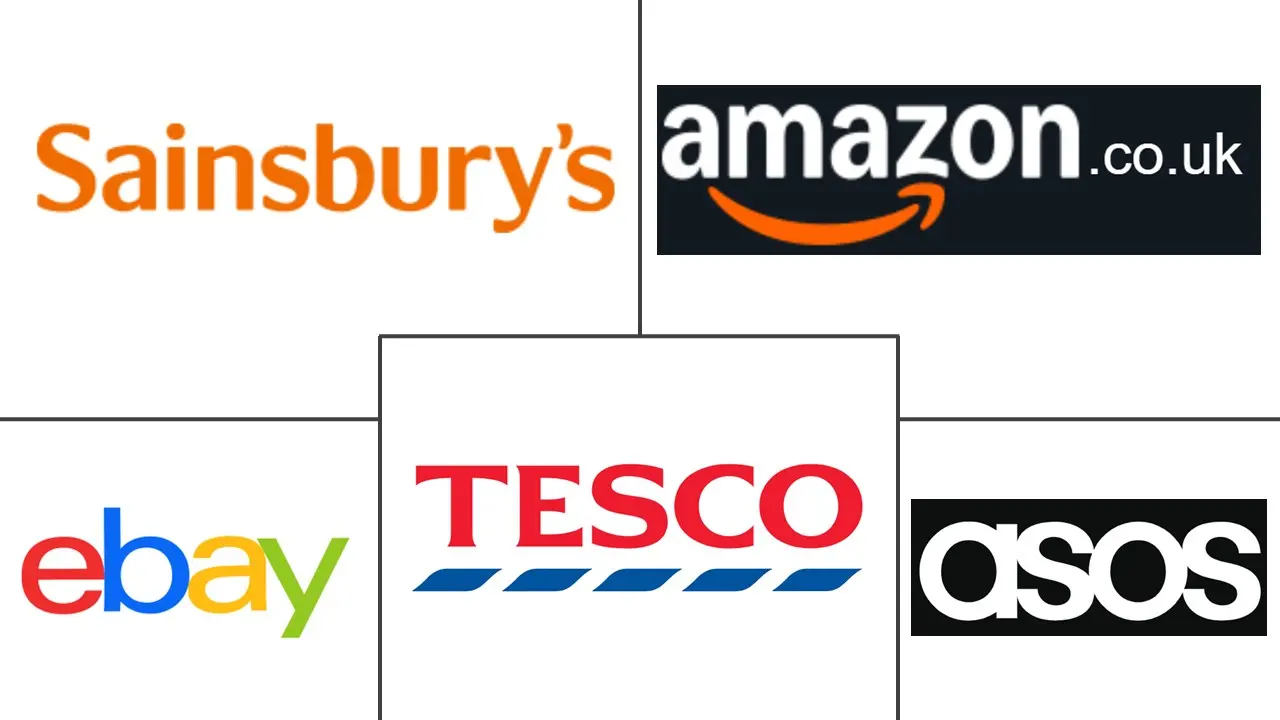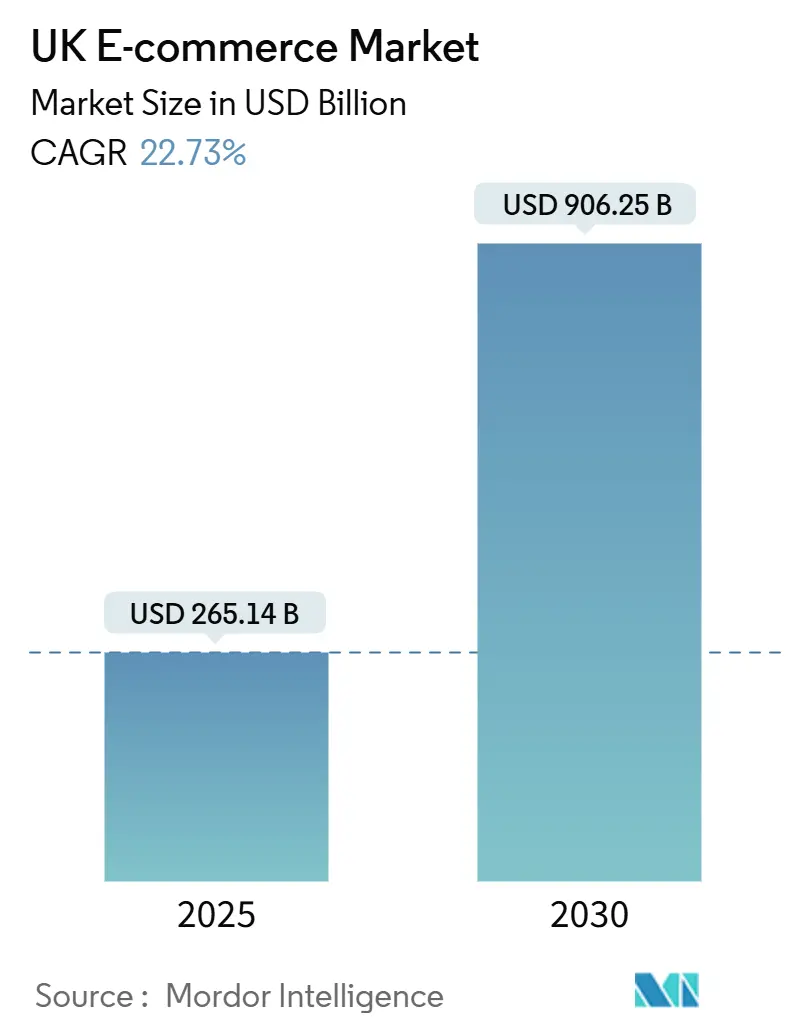
UK E-commerce Market Analysis by Mordor Intelligence
The UK e-commerce market stands at USD 265.14 billion in 2025 and is forecast to climb to USD 906.25 billion by 2030, translating into a 22.73% CAGR. Robust connectivity, almost universal digital-payment acceptance and a retail culture quick to test new formats keep the UK e-commerce market at the forefront of European online retail. Mobile shopping already accounts for more than half of digital checkouts, and the nationwide roll-out of 5G is lifting conversion rates further as richer, faster pages reduce abandonment. Retailers are responding with aggressive investments in same-day fulfilment, automated warehouses and live-shopping studios, while B2B platforms increasingly mirror B2C user experience to capture procurement budgets migrating online.
Key Report Takeaways
- By business model, the B2C segment held 88% of the UK e-commerce market share in 2024; B2B is set to expand at a 24.5% CAGR between 2025-2030.
- By device type, smartphones captured 55% of transactions in 2024, while mobile commerce is projected to grow at a 23.5% CAGR to 2030.
- By payment method, credit and debit cards secured a 33% share of the UK e-commerce market size in 2024; Buy Now, Pay Later leads growth at a 21.6% CAGR through 2030.
- By product category, fashion and apparel led with 29% revenue share in 2024; food and beverages is forecast to expand at a 23.5% CAGR to 2030.
- Amazon accounted for 12.7% of the top 20 online stores’ sales in 2023, underscoring its continued dominance.
UK E-commerce Market Trends and Insights
Drivers Impact Analysis
| Driver | (~) % Impact on CAGR Forecast | Geographic Relevance | Impact Timeline |
|---|---|---|---|
| Widespread 5G roll-out | +3.2% | National, with early gains in urban centers | Medium term (2-4 years) |
| Proliferation of secure digital payments | +2.8% | Global, with strong UK adoption | Short term (≤ 2 years) |
| Rising mobile-commerce share in retail | +4.5% | National, with higher impact in metropolitan areas | Short term (≤ 2 years) |
| Same-day/next-day delivery expectations | +3.1% | National, concentrated in urban centers | Medium term (2-4 years) |
| Surging adoption of social-commerce 'live shopping' | +2.6% | National, with higher adoption among younger demographics | Medium term (2-4 years) |
| Expansion of on-graduation student marketplaces | +1.5% | National, concentrated in university towns | Long term (≥ 4 years) |
| Source: Mordor Intelligence | |||
Widespread 5G roll-out
Ubiquitous 5G is shrinking page-load times by 70%, cutting cart abandonment by 15% and enabling mass adoption of augmented reality product previews. More than half of online shoppers now use AR when considering furniture or fashion, boosting conversion by up to 40%. Retailers also exploit 5G for real-time inventory feeds that reduce stock-outs by 30%, while predictive analytics trims excess stock-holding costs. Industry modelling suggests 5G could inject an additional USD 15.7 billion into retail revenues in 2025 alone. [1]GSMA, “The Mobile Economy 2024,” gsma.com These gains accelerate a mobile-first cycle in which faster networks reinforce consumer preference for on-the-go shopping and drive competitive pressure on slower rivals.
Proliferation of secure digital payments
Card schemes process 97.1% of online UK transactions, yet digital wallets now appear in 82.2% of baskets, helping cut checkout times by 37% and squeezing fraud by 29%. [2]UK Finance, “UK Payment Markets Summary 2024,” ukfinance.org.uk Biometric authentication is edging passwords aside, and Buy Now, Pay Later already funds 13.9% of Christmas online spending, equivalent to USD 3.6 billion in 2024. Estimates put the BNPL funnel at USD 44.8 billion by 2028, doubling its 2022 level. Frictionless payment choice therefore remains one of the clearest levers for basket conversion, customer loyalty and, in aggregate, the growth of the UK e-commerce market.
Rising mobile-commerce share
Smartphones generated 75% of retail site visits in Q2 2023 and now account for 55% of completed online purchases. [3]Office for National Statistics, “Retail sales, Great Britain: March 2025,” ons.gov.uk Progressive Web Apps deliver native-app fluidity without download barriers, raising conversion by 36% over mobile websites, while one-click ordering mitigates the 70.19% abandonment rate tied to complex checkouts. Behavioural data further show that 49% of smartphone users compare prices mid-aisle, reinforcing transparency and competition. With mobile traffic expected to reach 80% of total internet use by 2028, optimising for hand-held navigation is no longer optional.
Same-/next-day delivery expectations
Eight in ten UK shoppers expect same-day options, and two-thirds of retailers plan to comply within two years [deliveryapp.com]. Amazon alone earmarked EUR 700 million (USD 760 million) for new European delivery-station technology and will expand same-day coverage to 155 locations by the end of 2025. The densely populated urban core—44% of citizens live in major cities—offers geographic economies of scale unavailable to more dispersed markets. Retailers adopting rapid-delivery services report higher repeat-purchase rates and premium basket sizes, offsetting the cost of last-mile infrastructure and intensifying the logistics arms race within the UK e-commerce market.
Restraints Impact Analysis
| Restraint | (~) % Impact on CAGR Forecast | Geographic Relevance | Impact Timeline |
|---|---|---|---|
| Heightened data-privacy regulation (DPDI Bill) | -2.1% | National, with implications for cross-border trade | Medium term (2-4 years) |
| Intense price competition compressing margins | -3.4% | National, with greater impact in fashion and electronics | Short term (≤ 2 years) |
| Warehousing labour shortages outside 'Golden Triangle' | -1.8% | Regional, concentrated outside the Midlands logistics hub | Medium term (2-4 years) |
| Volatile cross-border VAT reverse-charge rules | -1.7% | National, affecting EU-UK trade | Short term (≤ 2 years) |
| Source: Mordor Intelligence | |||
Heightened data-privacy regulation
The Data (Use and Access) Bill introduces new lawful bases for processing and strengthens individual redress, forcing retailers to reconfirm consent flows and overhaul data-handling protocols. Compliance costs could reach USD 1-1.6 billion across the sector, while any misalignment with EU adequacy threatens friction in cross-border sales. Ecommerce operators now weigh the marketing upside of granular personalisation against the liabilities of tighter audit trails, a calculation likely to temper data-driven growth over the medium term.
Intense price competition
Transparent pricing tools and the cost-of-living squeeze funnel consumers toward the lowest visible tag, compressing gross margins—particularly in fashion where online returns hit 27%, more than double physical-store levels. Ultra-budget platforms such as Temu accentuate the race to the bottom, while higher logistics and compliance outlays erode headroom for discounting. Market participants respond with own-label ranges, AI-driven dynamic pricing and experiential perks designed to shift the narrative away from price alone. The strategic split between premium, service-led retailers and pure-price merchants is likely to widen, constraining mid-tier operators in the UK e-commerce market.
Segment Analysis
By Business Model: B2B platforms accelerate digital procurement
B2C transactions supplied 88% of revenue in 2024, yet the B2B channel is projected to outpace the overall UK e-commerce market with a 24.5% CAGR through 2030 as corporate buyers migrate to self-service apps. The segment’s share of digital revenue is forecast to reach 56% in 2025, signalling structural change in industrial purchasing habits. Group purchasing features, credit management modules and plug-and-play catalogue integration make marketplaces attractive to small suppliers seeking reach without heavy infrastructure investments. Large distributors now expose real-time stock data via APIs, letting customers automate replenishment cycles and cut purchase-order administration costs. This operational efficiency unlocks working-capital benefits and cements retention, positioning B2B commerce as a durable growth engine within the UK e-commerce market.
Second-generation features such as configurable pricing, quick-quote engines and AI-assisted cross-selling draw on B2C playbooks to raise average order value. Agricultural inputs, healthcare consumables and foodservice ingredients show particularly high penetration of online tendering systems. Institutional buyers, pressured by ESG reporting, also favour platforms able to surface provenance data at line-item level. These dynamics, coupled with widening broadband access in rural areas, give B2B market leaders scope to aggregate fragmented long-tail suppliers and extend the UK e-commerce market size into new verticals.
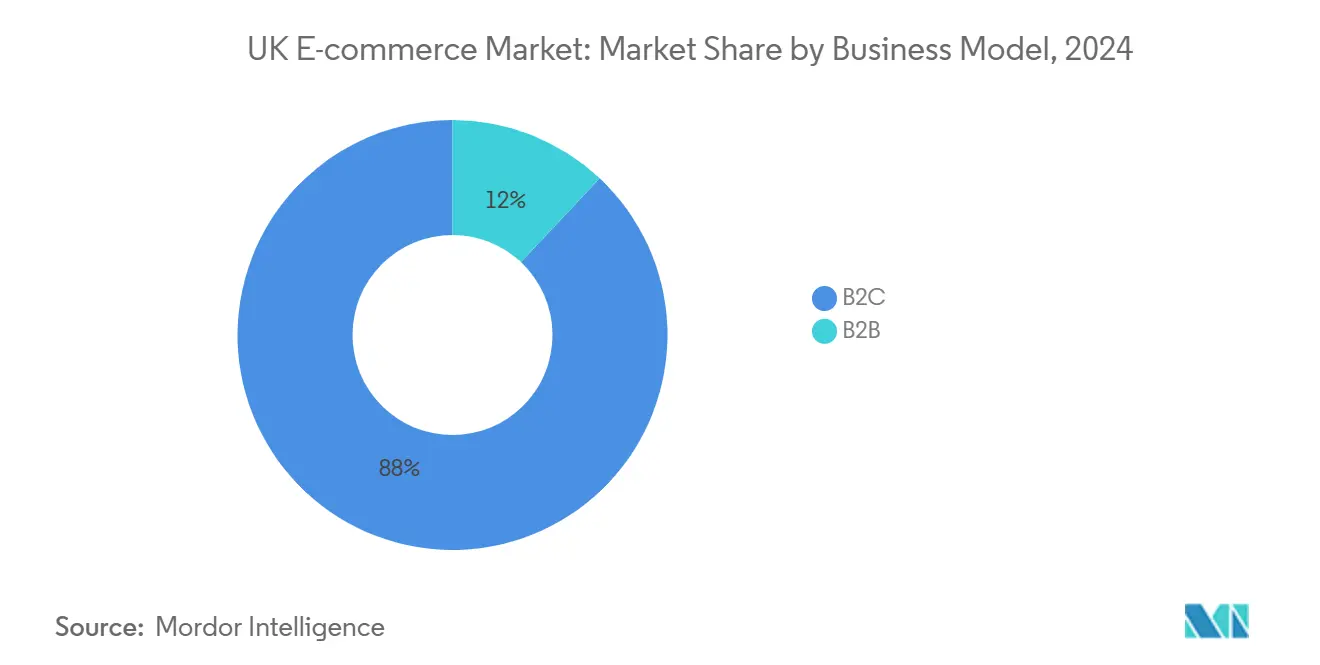
By Device Type: Mobile rewrites experience architecture
The UK e-commerce market size attributed to smartphones reached more than USD 100 billion in 2025 as mobile claimed 55% of total transaction value and is tracking a 23.5% CAGR toward 2030. Voice search, haptic feedback and camera-based sizing tools now shape the path to purchase, compressing discovery and checkout into minutes. Retailers report that app users convert at 1.5-times the rate of mobile-web visitors and post 15% higher average order values. Developers therefore prioritise native or hybrid frameworks that support push-led remarketing, offline browsing and biometric pay in a single tap.
Desktop still plays a role for high-involvement purchases—think travel bundles or bespoke furniture—where extended comparison and configuration capabilities trump speed. Tablets, smart TVs and emerging headset interfaces contribute incremental volume, especially for home shopping events and live-stream promotions. As generative AI translates voice prompts into shoppable recommendations, device-agnostic journeys will converge, yet performance standards set by smartphones are likely to define baseline expectations across the UK e-commerce market.
By Payment Method: BNPL reshapes consumer financing
Cards processed 33% of online payments in 2024, a testament to entrenched habits and reward schemes, but growth momentum lies with BNPL, advancing at a 21.6% CAGR to 2030. BNPL appeals to 69% of millennials and 68% of Generation Z, who cite flexibility and interest-free instalments as main draws. Regulatory proposals scheduled for 2026 will compel providers to embed affordability checks, adding friction but also legitimising the model for wider adoption.
Digital wallets, with PayPal at 82.2% penetration, enjoy customer trust and integrate seamlessly with one-click flows. Open-banking transfers, crypto checkouts and account-to-account rails still trail but win share where settlement speed or irrevocability is critical. Merchants layer multiple options both to maximise authorisation rates and to hedge exposure to any single scheme. This diversity ensures that payment innovation remains a competitive lever in the UK e-commerce market.
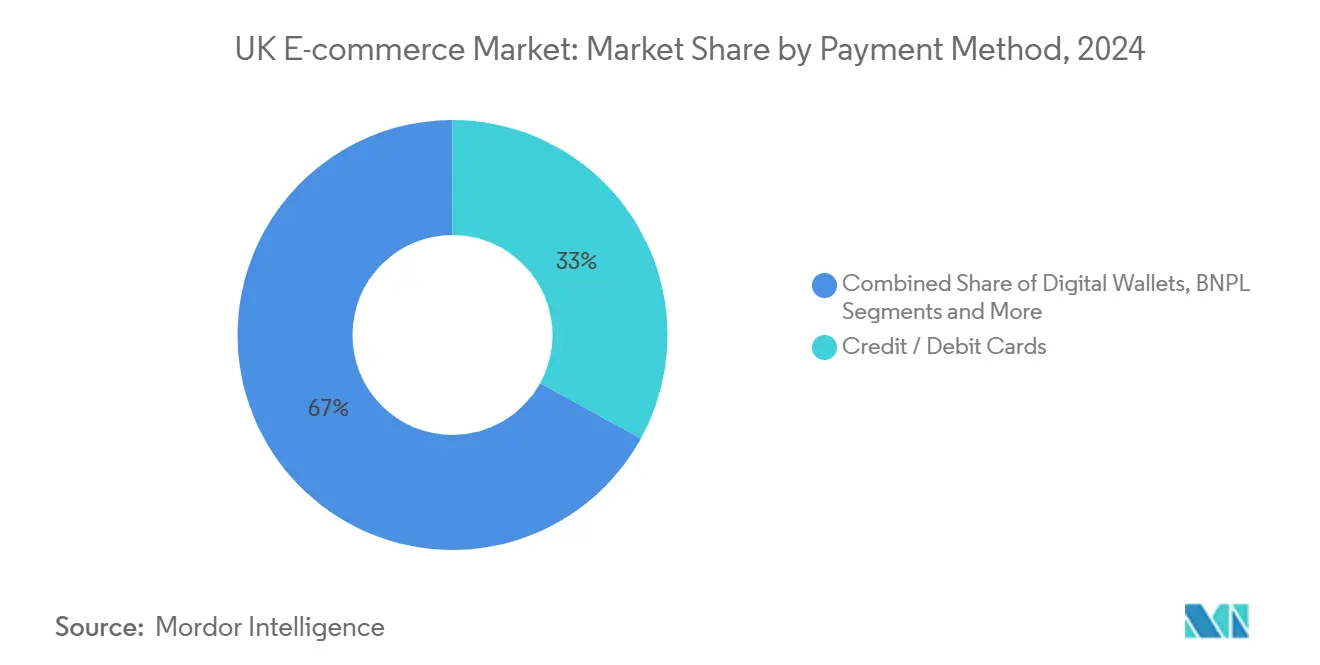
Note: Segment shares of all individual segments available upon report purchase
By B2C Product Category: Food and beverages steal the growth spotlight
Fashion retained a 29% revenue share in 2024 thanks to the UK’s style-centric consumer culture and the sector’s early digital pivot. Yet strong return volumes and promotional headwinds temper net profitability. In contrast, food and beverages are projected to post a 23.5% CAGR between 2025-2030, fuelled by meal-kit subscriptions averaging USD 2,555 per household annually. [4]Food and Drink Federation, “E-commerce in Food and Drink,” fdf.org.uk Rapid-delivery grocery partnerships and dark-store networks further tilt convenience economics in favour of online channels.
Beauty and personal care thrive on social-commerce amplification, while consumer electronics command 16.5% of revenue amid robust demand for gaming accessories forecast to reach USD 15.1 billion by 2032. Furniture merchants deploy AR room-scanning tools that cut return costs, and specialist marketplaces serve hobbyist niches in DIY, toys and collectibles. These category nuances reinforce the breadth of addressable demand and highlight opportunities for tailored merchandising as the UK e-commerce market grows in complexity.
Geography Analysis
The UK remains Europe’s largest digital retail economy and ranks third globally behind the United States and China. Online volumes captured 26.8% of total retail sales in March 2025 and are on course to exceed 31% by 2028. Turnover hit a record USD 127 billion in 2024, aided by mature logistics corridors and near-universal broadband coverage. The Midlands’ “Golden Triangle” continues to anchor fulfilment infrastructure, yet labour shortages outside this zone inflate warehouse wages and push operators toward automation.
Cross-border trade comprises 12% of UK e-commerce orders. Apparel and footwear dominate outbound parcels, reflecting strong brand equity among EU consumers. Brexit, however, rescinded distance-selling VAT schemes, raising paperwork and eroding small-seller margins as exports to the EU slipped 4% to USD 212.18 billion in 2024. The 2025 UK-EU Trade Deal offers partial relief via streamlined agrifood checks, yet friction persists around rules-of-origin and reverse-charge VAT obligations, creating compliance overhead that favours scale players.
Domestic demand remains buoyant. London and the South-East deliver outsized volume thanks to income density, but regional growth hotspots include Manchester, Birmingham and university towns where on-graduation marketplaces connect students with micro-sellers. Rural Wales and Scotland experience uptake as improved last-mile propositions narrow delivery-time gaps. Meanwhile, 5G penetration progresses from metropolitan cores to suburban belts, levelling access to high-bandwidth retail experiences and reinforcing the UK e-commerce market’s national footprint.
Competitive Landscape
The UK e-commerce market shows moderate concentration. Amazon generated USD 16.61 billion in 2023 sales, securing 12.7% of the top-20 store revenue pool and leveraging Prime, marketplace breadth and proprietary fulfilment robotics to defend share. Grocery giants Tesco and Sainsbury’s amplify omnichannel momentum; Sainsbury’s online turnover reached USD 2.16 billion in 2024, buoyed by click-and-collect penetration that absorbs store network fixed costs. Tesco’s 2025 launch of a third-party marketplace extends its range without inventory risk, signalling a pivot toward platform economics.
Strategically, leaders prioritise speed and convenience. Amazon’s AI-enabled Vulcan arm exemplifies automation’s role in shrinking unit fulfilment costs, while Screwfix’s 60-minute Sprint service underscores vertical-specific urgency among trade customers. Social-commerce disruptors such as TikTok Shop amplify discovery and impulse purchase, compelling established brands to build live-shopping capabilities and recalibrate marketing spend. BNPL specialists, payment orchestrators and same-day logistics providers form a secondary layer of critical infrastructure partners whose performance directly influences merchant competitiveness across the UK e-commerce market.
White-space opportunities cluster in B2B verticals, localisation services and sustainability logistics. Firms that can certify low-carbon delivery or circular-economy packaging win enterprise contracts amid rising ESG disclosure mandates. Likewise, AI chatbots and personalisation engines that integrate privacy-by-design stand to gain as data-governance rules tighten. Overall, the balance of power tilts toward organisations capable of scaling technology investments quickly while preserving brand trust and operational resilience.
UK E-commerce Industry Leaders
-
Amazon UK Services Ltd.
-
eBay (UK) Ltd.
-
ASOS plc
-
Tesco plc (Tesco.com)
-
Sainsbury’s Argos Ltd.
- *Disclaimer: Major Players sorted in no particular order
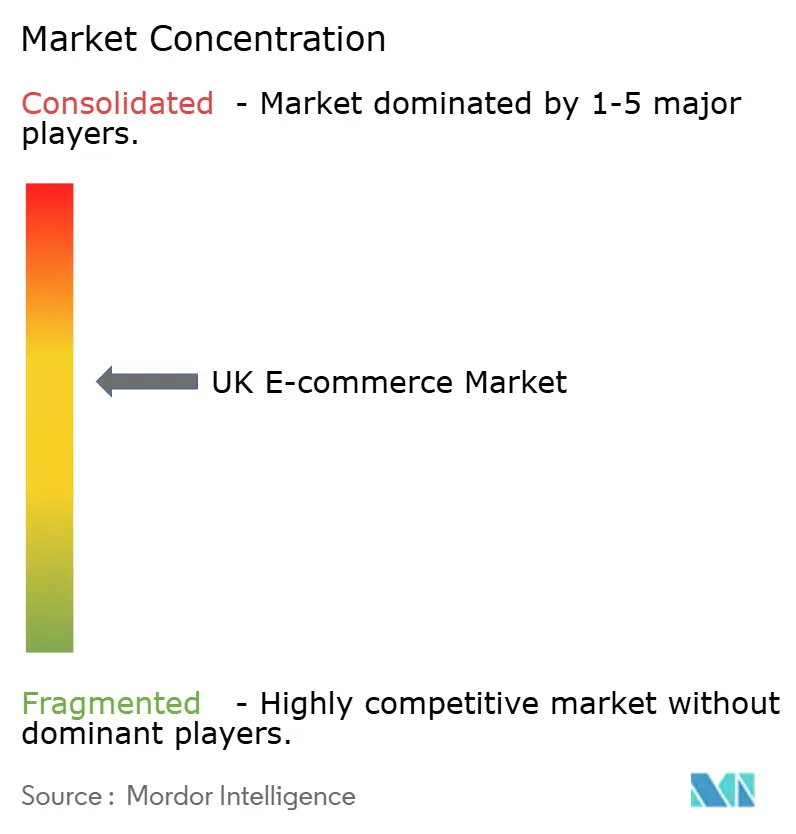
Recent Industry Developments
- May 2025: Amazon unveiled the Vulcan AI-powered robotic arm and confirmed same-day delivery expansion to 155 UK locations, reinforcing its fulfilment edge.
- April 2025: Tesco introduced a third-party marketplace, leveraging customer trust to broaden the assortment without carrying inventory risk.
- March 2025: The Office for National Statistics reported a 2% monthly rise in online sales volumes, marking the second consecutive month of growth.
- February 2025: ASOS, despite an 18% revenue dip in FY 2024, outlined efficiency measures aimed at a return to EBITDA growth in H1 FY25 [asos.com].
Research Methodology Framework and Report Scope
Market Definitions and Key Coverage
Our study defines the United Kingdom e-commerce market as the gross merchandise value generated when domestic consumers or enterprises purchase physical goods or services online through websites, mobile apps, or social storefronts, with payment processed digitally and fulfillment handled by mail, courier, or click-and-collect.
Scope exclusion: Sales where the merchant of record is registered outside the United Kingdom and pure digital-only media subscriptions are not counted within this scope.
Segmentation Overview
- By Business Model
- B2C
- B2B
- By Device Type
- Smartphone / Mobile
- Desktop and Laptop
- Other Device Types
- By Payment Method
- Credit / Debit Cards
- Digital Wallets
- BNPL
- Other Payment Method
- By B2C Product Category
- Beauty and Personal Care
- Consumer Electronics
- Fashion and Apparel
- Food and Beverages
- Furniture and Home
- Toys, DIY and Media
- Other Product Categories
Detailed Research Methodology and Data Validation
Primary Research
Interviews with marketplace category heads, parcel integrators, payment-service executives, and small web-store owners across England, Scotland, Wales, and Northern Ireland confirmed basket sizes, return ratios, and segment growth expectations, letting us fine-tune assumptions drawn from desk work.
Desk Research
We began with the Office for National Statistics monthly internet retail turnover, HMRC customs declarations, and UK Finance card-payment dashboards, which anchor overall spending. Insights from the Interactive Media in Retail Group, Royal Mail parcel statistics, and open-access academic studies enriched our understanding of buyer behavior and delivery trends. Company 10-Ks and investor decks accessed via D&B Hoovers, together with news archives on Dow Jones Factiva, supplied channel-level revenue clues and pricing context. The sources cited are illustrative; many other credible records guided data collection, validation, and clarification.
Market-Sizing & Forecasting
A top-down build started from ONS internet sales, expanded with trade data to capture B2B flows, and was cross-checked against a selective bottom-up roll-up of leading merchant revenues and sampled ASP × volume calculations. Key variables modeled include smartphone share of checkouts, parcel density per capita, digital-wallet penetration, average return percentage, promotional intensity, and real disposable income. Forecasts employ multivariate regression blended with ARIMA to capture structural drivers and seasonality. Data gaps were bridged using analog sub-segment benchmarks before final triangulation.
Data Validation & Update Cycle
Outputs undergo variance tests against independent parcel volumes and network-payment totals, followed by peer review of anomalies. Models refresh annually, with interim updates triggered by material regulatory or technology events, ensuring clients receive the latest view.
Why Mordor's UK Ecommerce Baseline Commands Reliability
Published estimates often vary because firms apply different scopes, price series, and refresh cadences.
By grounding values in current ONS data, corroborating them through targeted field interviews, and updating every year, Mordor Intelligence delivers a balanced, dependable starting point for decision-makers.
Benchmark comparison
| Market Size | Anonymized source | Primary gap driver |
|---|---|---|
| USD 265.14 B (2025) | Mordor Intelligence | - |
| USD 285.60 B (2025) | Regional Consultancy A | Adds travel and event tickets; refreshes biennially |
| USD 129.71 B (2024) | Global Consultancy B | Counts only physical goods B2C; excludes B2B; conservative ASPs |
| USD 829.16 B (2024) | Industry Journal C | Bundles digital content and peer payments; optimistic scenario |
Differences stem mainly from scope stretch and dated inputs; our disciplined blend of public statistics and primary checks keeps Mordor's baseline transparent, reproducible, and trustworthy.
Key Questions Answered in the Report
What is the current size of the UK e-commerce market?
Online retail sales reached USD 127 billion in 2024, and the sector continues to grow faster than store-based retail.
How fast is mobile commerce growing in the UK?
Smartphones already handle 55% of transactions and are forecast to expand at a 23.5% CAGR through 2030, driven by 5G and app adoption.
Which business model is expanding quickest?
B2B digital procurement is scaling at a 24.5% CAGR as companies shift from phone-based ordering to self-service marketplaces.
Why is Buy Now, Pay Later important?
BNPL funds 13.9% of online holiday spending and is projected to more than double in value to USD 44.8 billion by 2028, making flexible credit a key driver of conversion
What regulatory changes should e-commerce firms watch?
The Data (Use and Access) Bill tightens privacy rules, and the General Product Safety Regulation raises compliance requirements for EU-bound products, increasing operational complexity.
How are delivery expectations evolving?
Eight in ten shoppers now expect same-day fulfilment, prompting retailers to invest in micro-fulfilment and automation to stay competitive.
Page last updated on:
